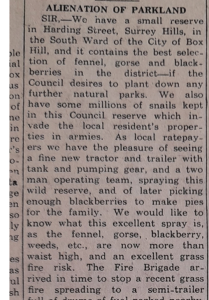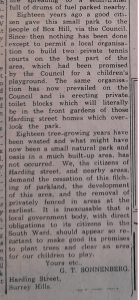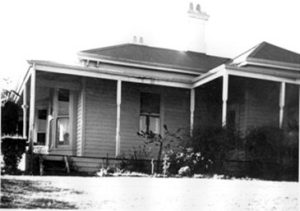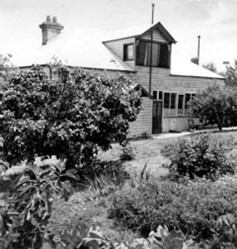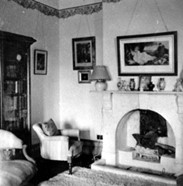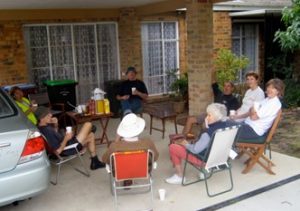Bluebell Hill Reserve History
In 1854, “The roads were on paper only and were tracks through a half wild region. The trip to Melbourne took 2–3 days by saddle hack,
dray or bullock wagon” from Surrey Hills area. As Melbourne expanded, a latticed wooden bridge was erected across the Yarra River in 1858, [now the site of the Johnson Street Bridge.] This expedited settlement to the east.
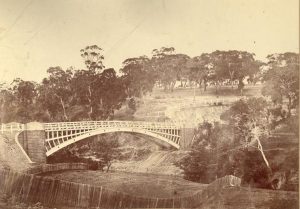
Topography maps of the Bluebell Hill area of 1850 do not show any roads, but do show survey lines, Gippsland track and Delaney’s Farm with track [probably now Broughton Road] and Delaney’s Hill, where Back Creek rises, and is the site of the Bluebell Hill Reserve.
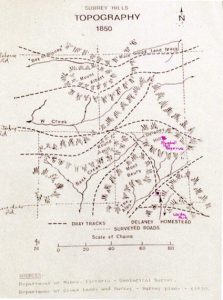
But within the year, surveys had been completed and our main roads were delineated. Surrey Hills was in the Roads District of Nunawading [Shire in 1857]. From this time on, settlement increased, and increasing numbers of farms, then residential subdivisions.
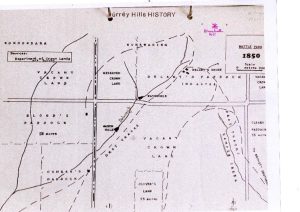
One of the earliest settlers was John White who migrated with his wife from Cornwall to Victoria in 1848. He was a quarryman by trade, and in 1854 he purchased a large block of land from William Morton for 674 pounds in Surrey Hills. This land extended from “west side of Pembroke Street … to Everton Grove, and south from Canterbury Road to Shepherd Street”. “this area included house sites on west of Pembroke Street, all of the current Harding Street, parts of Edyvean Street, Howell Avenue and Shepherd Street. It is believed the current parkland was one of his quarries.”[1]
In 1864 White sold the land to Henry Hardware, but seems to have leased at least part of it for some time after. By 1868 Rate books showed the presence of a timber farmhouse, orchard and vineyard owned by John Barratt. The property was named “Bluebell Hill Vineyard”. [2] To this day, bluebells pop up in the parkland and surrounding gardens.
In 1877, much of the property was bought by Dr L L Smith for 546 pounds. [1] On the site he developed “an immense chicken farm” to become known as the ‘Chicken Farm Estate’. When this farm was later subdivided and offered for sale the name was changed, as it was deemed “undesirable”.[2]
The railway to the east of Melbourne was extended and duplicated to Box Hill in 1888. The same year an extensive timber home was erected at what is now 15–17 Harding Street, directly opposite what is now the Reserve. This home was named Corona.
|
|
|
|
|
|
A carriageway ran from the stables to the corner of Canterbury Road.
By the early 1900s other homes were erected in the area, and the original holding was now reduced.
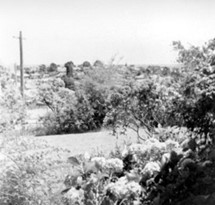
At this time the land on the both the west and east side of Harding Street from Canterbury Road to Erasmus Street was owned by the Shain family. This included the old quarry land.[3] A record exists of the death of Mrs Laura Shain of ‘Corona’ in 1917. [3]

In 1922 Mr Shain sold Corona [lots 28–32 of the old Chicken Farm Estate] to Mr W F Gill, and this family lived there until the early 1950s.[3] In 1927, Mr Shain offered the downhill land [Lot 61, now much of the present parkland, to the Box Hill Council.[3]
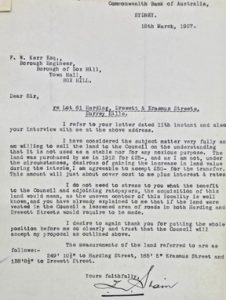
Searches do not reveal this transaction, but anecdotal evidence from the time suggests that the Council took over the land.
In the mid 1900s, the Baptist Church was granted permission to erect 2 tennis courts on some of the land. Use was limited to the Church and could not be used on Sundays. However it seems the rest of the open space was unkempt, as the resident of 19 Harding Street, George Sonnenberg wrote to Council in 1957[5], despairing at Council’s lack of care …”We have millions of snails + best selection of blackberries… fire brigade truck recently put out a fire.” He also laments the lack of a promised children’s playground. See attachment 1. Oral history of the time also records grass fires, and the fence of 14 Harding being burnt; also of children using flattened cardboard boxes to slide down the steep embankment.
In 1965 Box Hill Council decided to donate this open space in Harding Street to the Boy Scouts for a Scout Hall and Car park. This would have used all the flat area of the parkland. [Note: At this time, scouts already had a large hall to the east of Elgar Road] This proposal caused strong reaction from Harding Street residents and the local community. They saw this action as erosion of limited open space, such as it was. And others such as those children who slid down the hill, or played among the shrubs were also very upset. Local residents got together and focussed on how to protect the open space. First of all they wrote a letter to Box Hill Council objecting to the proposal.
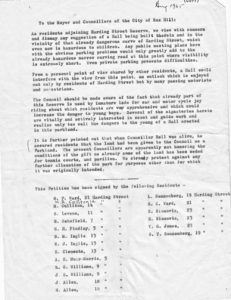
As the Council was uncompromising, the community raised money to obtain legal assistance. With active local newspapers at the time, this became a newsworthy event to focus on. Now, suddenly, the history of the park and its ownership became important. Research by the residents’ legal representative, Mr Bruckner, revealed the Box Hill Council did not own some of the park. [It had belonged to a now defunct company].
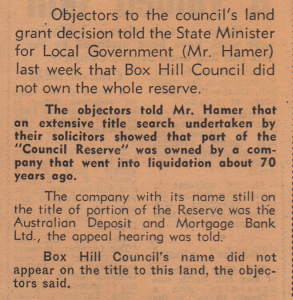
Also, a previous Councillor had assured residents that much of the land had been ‘gifted’ to Council to be used specifically as Parkland — maybe it was the offer by Mr Shain in 1927. The residents pressed on with their effort to keep their park. All this activity by the community drew the attention of the local papers.
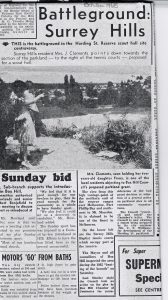 |
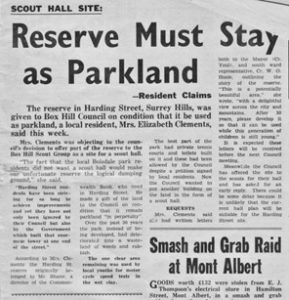 |
Mr Bruckner helped to put a submission to the Town and Country Appeals Board. As the Council refused to negotiate, the matter was finally resolved after almost two years, in favour of the residents, and the community retained their open space.
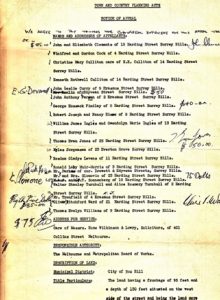
In 1967, having finally acknowledged that it was indeed parkland, Council now did the minimal amount to keep the weeds down or do any maintenance. It was for many years unkempt open space, the responsibility of the Box Hill Council, which found it difficult to maintain due to the steep hillside. Children continued to slide down the steep hill in areas free of weeds and shrubs; and the tennis courts were used. The Club which held the tennis court lease would not grant access to the local community, even while the courts were in an increasing state of disrepair; and the park was becoming overgrown with weeds.
In 1985 the Box Hill Council finally became involved, removing the Club’s lease and developing a plan which create a playground to the west of the courts, a circular path, and planting of acacia and bursaria on the hillside. However, little was done to make the flat area of the park more usable, muddy in winter and sun-baked clay and weeds in the summer. Also, the tennis courts became more run down. Led by the McMillans, the local community once again became involved. Information and logo supplied by C & J McMillan:
In 1988 the Box Hill Council placed an advertisement in the local paper requesting applications for the management of the lease for the Harding Street tennis courts.
A group of local young mothers played at the courts every Friday morning and suggested that Jill McMillan should respond to the advertisement so they could continue to play on the courts.
Jill took up the offer and placed a letter of interest at her front door for local people to sign. This letter was advertised by word of mouth and was very well received. She spoke to neighbours and formed a small working party to assist her. A group meeting was held in her home including Roland Hasell, Brian Fittz, Martin Brainy and herself, where various aspects of the club were discussed. Due to the support demonstrated by the locals it was decided to limit membership to local residents with no more than one hundred single or family memberships so the courts could cater for the increased intended usage.
Following this, a well-attended public meeting was held at the Harding Street Park, by the tennis courts, chaired by Brian Fitz.
As a result, the Bluebell Tennis Club was formed with Jill McMillan as President and an application was submitted to the Box Hill Council to lease the courts. The lease was granted.
Memberships were taken up quickly and a waiting list arranged when the numbers reached the limit. Members made full use of the courts with regular games of a Friday morning, Saturday afternoon, Monday night pizza gatherings, along with family and friends playing at all other times.
Before long members requested that coaching be provided for members of all ages. Thus, Peter Owen started a long association with the club.
The courts were in a state of neglect but fortunately the Council aided with re-fencing and supported the resurfacing. These were supported by Mr Tom Thorpe, Mayor, and Cr Phillip Tuckett.
A logo was designed by Mr Ron Wootton, art teacher at Camberwell Grammar. This still appears on signage today.
Jill McMillan resigned as President in 1993 when she went overseas with her husband and children for twelve months.

In 1994 when Councils were amalgamated in Victoria, Box Hill was absorbed into Whitehorse. Appeals from residents to improve the park continued to fall on deaf ears, as there were ‘real’ parks in the Nunawading area that needed maintenance.
It was not until 2003 when some Harding Street residents gathered together and with the help of then new Councillor, Sharon Ellis, were able to form a Parkland Advisory Committee. There was an early setback when in the same year the old tennis club burnt down. Council provided funding for a new clubhouse which was erected in 2005. With enthusiasm, ongoing small grants, and increasing co-operation from Council the group worked across the ensuing years, slowly improving the park by clearing and planting bird attracting natives.
The Whitehorse Council was now taking more interest in the park, which is situated on one of the highest points within the 12 kilometre radius of Melbourne, and has long been a site for people wanting to look quietly at the sunset over Melbourne, or family groups coming to watch such spectacular events as fireworks displays in the city. In 2007 a lookout was erected at the North-East corner of the park, and it is well used.
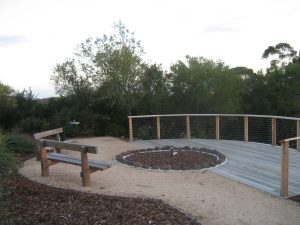
Across the following years, many of the original Committee remained and relationship with Council continued to improve. In 2015 the committee initiated the process [completed in 2017] of giving the park a name associated with its history, that of Bluebell Hill Reserve. During this time Council started the planting of grass in the flat areas of the park, and clearing the hillside. This is where the work parties focussed on re-planting.
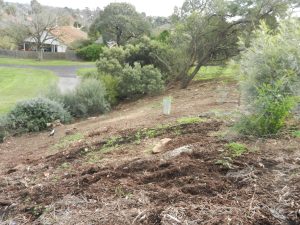 |
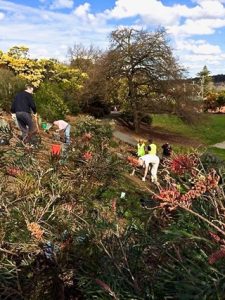 |
The Council now started to work on a concept plan in conjunction with the Committee. In. 2017–18 a new playground, further from the road, was built.
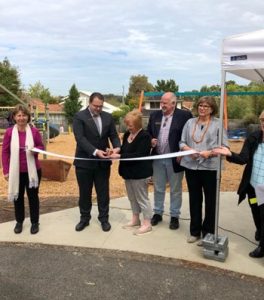
Just as the Covid-19 virus lockdowns began in 2020, the park concept plan was put into action by Steve Day, the Horticultural Coordinator at Council, and now we have a real ‘garden’ parkland. It was well used during those restricted times. Among our proudest achievements are the clearing and replanting of the hillside; helping to maintain the park in good order through working bees; and working with Council to achieve a revitalised park.
We have 4 committee meetings and 4 work parties a year. We all contribute according to our ability and time availability. Behind the actual work parties lies the organisation of, finances, correspondence [from and to Council], revising objectives reporting on problems [eg fallen trees etc]. contacting members, and organising work parties and the resources for these.
During the years since its formation, the Advisory Committee has worked along well together, and enjoyed each others’ company after a hard working bee!
Foundation members, Diana and Alan Foster, Joan and Peter Forsyth, and Elizabeth Meredith are still on the Committee; while across the years many others have served enthusiastically, both on the Committee and through working bees.
|
|
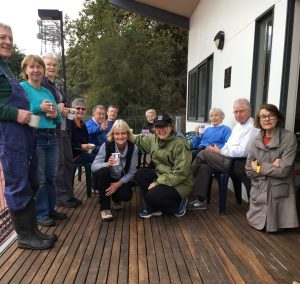 |
And the story of Bluebell Hill continues to evolve.
References
1 Jack Mclean — Great grandson of J White
2 Alan Holt — Surrey Hills Historian
3 Helen Harris [Box Hill Historical Society] — helped with data of historical purchases
Attachment 1. Letter of G Sonnenberg 1957
